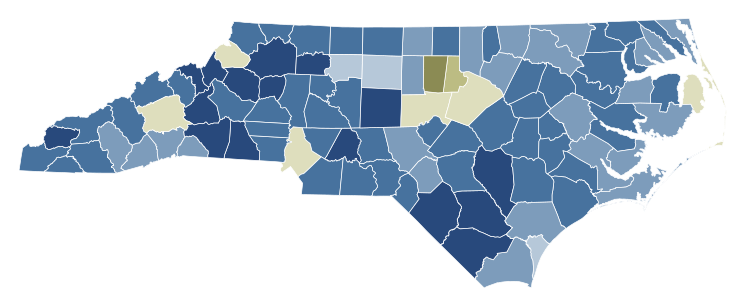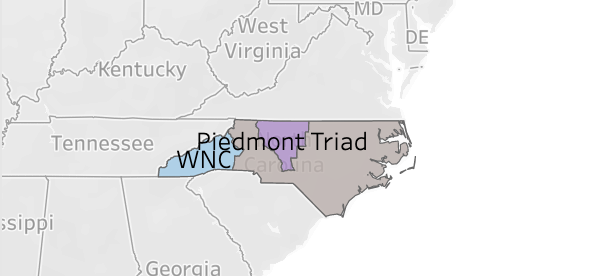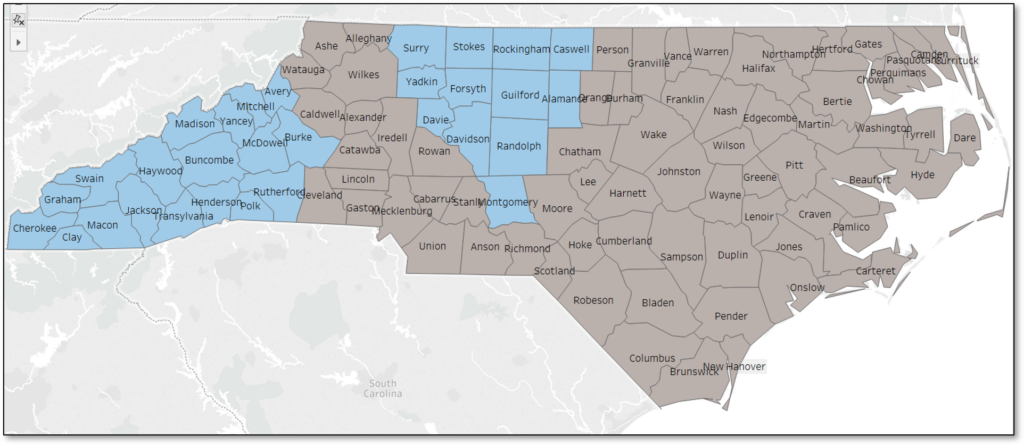ABOUT
the origin
The NC Investment Map
In recent years, stakeholders across North Carolina have mobilized behind an effort to improve value in the health system, including through greater investments in social drivers of health like food, housing, transportation, and jobs. However, to date these investments have been largely uncoordinated across funders, focused on immediate needs, and drawing on only a subset of potentially useful financial vehicles. Stakeholders across the state began to call for a way to improve the efficiency, effectiveness, and sustainability of these investments and, in turn, of the community resources and services they sought to support.
The result was a multisectoral collaboration to create the North Carolina Investment Map, a strategic and structured framework for mobilizing and aligning resources from public and private stakeholders in a coordinated way, to both improve health outcomes and strengthen the underlying economic context that enables health. The Investment Map initially focuses on ensuring sufficient healthy food and safe, affordable housing, through an economic development lens.

INVESTMENT MAP
Partners & Advisors
The North Carolina Investment Map is the result of a private-public multi-sector effort between the NC Department of Health and Human Services (DHHS), The Health Initiative, and partners and advisors from across the state with expertise in food, housing, and community capacity, including community-based organizations, state and local public agencies, private corporations, and philanthropic organizations.
- Appalachian Sustainable Agriculture Project
- Blue Cross NC Foundation
- Carolina Creative Works
- Center for Environmental Farming Systems
- Common Future
- Community Food Strategies
- Community Health Acceleration Partnership
- Community Solutions
- Cone Health
- Dogwood Health Trust
- Duke’s World Food Policy Center
- Feeding the Carolinas
- Forward Cities
- Gateway Wellness Foundation
- Health Care Without Harm
- High Point Food Alliance
- HOM Inc.
- Housing Assistance Corporation
- Kate B. Reynolds Charitable Trust
- MANNA FoodBank
- Mountain Housing Opportunities
- MountainWise
- NC DHHS
- NC Housing Finance Agency
- NC Network of Grantmakers
- Nonprofit Finance Fund
- Piedmont Triad Regional Council
- Policy Map
- Self-Help Credit Union
- The Community Foundation of WNC
- The Duke Endowment
- UNC-Greensboro Center for Housing & Community Studies
- United Way of Greensboro
- UnitedHealthcare Community Plan of NC
- Vaya Health
The promising strategies and funding estimates contained in this tool were developed collaboratively by participating partners and are not endorsed by DHHS.
HOW IT WORKS
What The Investment
Map Does
As a result of this collaborative effort, the North Carolina Investment Map now exists as a public resource that:

- Identifies statewide “promising strategies” for investment to ensure sufficient access to healthy food and affordable housing
- Recommends statewide measures to assess if those strategies are effective over time
- Analyzes the assets and gaps that exist relative to those strategies (in target regions)
- Estimates the total financial or other investment required to implement those strategies (in target regions and, in some cases, statewide)
- Identifies statewide “promising strategies” for investment to ensure sufficient access to healthy food and affordable housing
- Recommends statewide measures to assess if those strategies are effective over time
- Analyzes the assets and gaps that exist relative to those strategies (in target regions)
- Estimates the total financial or other investment required to implement those strategies (in target regions and, in some cases, statewide)
CRITERIA & PRINCIPLES
Informing The Investment Map's Guidance
The Investment Map is intended to inform not just what stakeholders can invest in for maximum impact, but also how. Recognizing that investments have the opportunity to have positive or negative side effects, the stakeholders behind the Investment Map placed community empowerment, economic opportunity, and racial equity as core values, alongside improved health outcomes.
As such, all of the Investment Map’s “Promising Strategies” meet detailed criteria and similarly, investment in alignment with the Promising Strategies should be informed by our core principles.
LOCATIONS
Initial Target Regions & Domains
The Map is intended to be a living tool that can inform investments in systems driving health across the state of North Carolina.
Although the first iteration of the Map focuses on food and housing systems, the Map can be updated and expanded to include other domains, such as transportation.
The Map’s recommendations in food and housing include strategies and measures chosen for their statewide relevance and value.
However, to quantify the assets, gaps, and necessary investments on a specific regional basis, two regions were chosen for initial analysis: Western North Carolina (18 counties) and the Piedmont Triad (12 counties).

These two regions were chosen according to the following criteria:
- Areas Hardest Hit by COVID-19
- Areas with Historically Marginalized Populations
- Areas with Racial and Health Disparities
- Opportunities for Institutional Investment
- Economic Distress Ranking
- Representation of Rural and Urban (inc. population centers)
- Primary Stakeholder Expertise
- Capacity of CBOs in the Region
As with the domains, the creators of the Investment Map hope that there will be an opportunity to expand the regions of focus in the near future.